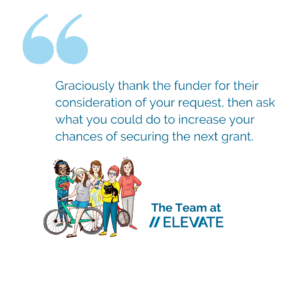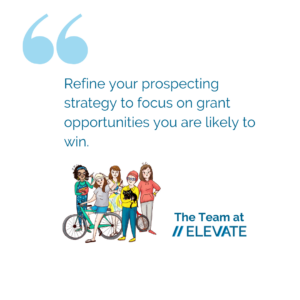If you’re a grant seeker, you’ve likely encountered these scenarios.
Scenario 1: You have an existing, positive relationship with a funder. You’ve submitted a proposal for an expanded or new initiative you thought would interest them, but you received a polite decline.
Scenario 2: You identified a perfect new funding prospect. You submitted an inaugural proposal after receiving the greenlight on an LOI, but ultimately the funder did not make an award.
We’ve all been there.
No one relishes hearing the word NO in response to a funding request. While sources vary, an estimated 80% of grant proposals are declined, so any grantseeker is bound to experience their share of rejections. But when you consider – as in all things in life! – that timing is everything, a “No” doesn’t have to remain a “No” for all time. It might help to think of “No” as “Not right now.”
To that end, the team at Elevate pulled together a few of our tried-and-true tips to help you convert a funder NO into a future YES.
1. Open yourself to feedback.
 There are many factors that go into funding decisions, both subjective and objective. While you believe in your mission and your organization does excellent work, don’t let that stand in the way of seeing how you can get another bite at the apple. Treat the declination as a valuable learning experience.
There are many factors that go into funding decisions, both subjective and objective. While you believe in your mission and your organization does excellent work, don’t let that stand in the way of seeing how you can get another bite at the apple. Treat the declination as a valuable learning experience.
In addition to graciously thanking the funder for their consideration, invest the time in asking what you could do differently to increase your chances of securing the grant in the next cycle.
If a funder shares any questions or concerns that arose from the proposal, use these inputs to help you shore up those elements for the next grant cycle, make your proposal more compelling, or strengthen an appeal to a different funder who may be interested in your project.
Additionally, in the case of funders that you have not been able to cultivate prior to a request, your first grant proposal might simply be your opportunity to introduce yourself. Consider that even if a proposal was declined, if it opened the door for you to develop a relationship with a new funder, it was by no means a waste of time or effort. Use any communication as an opportunity to reiterate your alignment with the funder’s interests and ask for feedback and an opportunity to apply again in the future.
2. Request a follow-up conversation.
 Not all program officers have the time or capacity to hold follow-up conversations about a declined proposal, but many do! Unless they explicitly state otherwise, you should absolutely take the opportunity to request feedback from the funder about your proposal. Request a phone call or meeting, and ask them how you may position yourself to be a more competitive applicant next time around. You can also gauge their interest in other facets of your programming in case something your organization does interests them more than what you originally proposed.
Not all program officers have the time or capacity to hold follow-up conversations about a declined proposal, but many do! Unless they explicitly state otherwise, you should absolutely take the opportunity to request feedback from the funder about your proposal. Request a phone call or meeting, and ask them how you may position yourself to be a more competitive applicant next time around. You can also gauge their interest in other facets of your programming in case something your organization does interests them more than what you originally proposed.
A meeting with a foundation program officer or Board member is a chance to get some behind-the-scenes information. For example, one Elevate team’s client was ostensibly within the funder’s geographic footprint based on eligibility criteria. However, upon speaking to the program officer, our client learned that the foundation had yet to ramp up their giving in the specific neighborhood where the organization is situated, and that they plan to do so the following year. With this encouraging news, the Elevate team planned to submit another request when the foundation was more likely to award a grant to our client.
Alternatively, if it’s challenging to get a meeting on the books, you could ask the funder via phone or email whether they would encourage your organization to reapply during the next grant cycle. Their response may end up yielding some useful insight about your likelihood of securing funding in the future.
3. Seek opportunities to expand your funder network.
 For the most part, foundations operate within a landscape of like-minded organizations, just as nonprofits do. Many funders maintain networks of other philanthropic organizations that share aspects of their giving priorities, and they may even participate in an affinity group of foundations with shared interests. For this reason, after a foundation declines your proposal, it can be valuable to appeal to the funder’s expertise when it comes to other organizations that share their funding priorities. Ask them about other organizations or foundations that they think may be interested in your work, and don’t be afraid to request an introduction to a good point of contact.
For the most part, foundations operate within a landscape of like-minded organizations, just as nonprofits do. Many funders maintain networks of other philanthropic organizations that share aspects of their giving priorities, and they may even participate in an affinity group of foundations with shared interests. For this reason, after a foundation declines your proposal, it can be valuable to appeal to the funder’s expertise when it comes to other organizations that share their funding priorities. Ask them about other organizations or foundations that they think may be interested in your work, and don’t be afraid to request an introduction to a good point of contact.
4. Offer to keep the funder in the loop about your organization.
Fundraising is a long game, so it’s important to be persistent when building a relationship with a grantmaker. As part of your stewardship efforts, you might offer to send periodic updates about your organization’s work or seek to connect with a potential funder through a site visit or a networking event. As a result, they may better understand your work – and your alignment with their interests – the next time you request funding.
5. Refine your prospecting strategy.
 Sometimes, a “No” truly is a “No.” If a program officer makes this explicit, it is not going to do you any good to persist—and may harm your organization’s reputation if you do!
Sometimes, a “No” truly is a “No.” If a program officer makes this explicit, it is not going to do you any good to persist—and may harm your organization’s reputation if you do!
However, this does not mean there isn’t something to learn from the scenario. Reflect on where you misunderstood your organization’s alignment with the funder’s interest, and use this to refine your prospecting strategy so that you can focus on grant opportunities that you are more likely to win.
Consider this example: A nonprofit organization focused on providing services to people who are unhoused submits a grant request to a funder with a broad priority of “housing security”. The request is declined, and after following up to ask for feedback from the program officer, the organization learns that this grantmaker invests in advocacy and systems change organizations rather than those providing direct services. With this information, the nonprofit refines its prospecting strategy to ensure that in the future it pursues grant opportunities with a clear interest in funding direct services.
The bottom line: In order to build a grant program, you are going to hear “No.” But do not despair! Your next steps will make all the difference when it comes to building relationships and refining your grantseeking strategy. And, sometimes you can make bad news work for you!
For more on how to make the most out of a declination, check out this article on Candid. Relatedly, see our blogs on “5 Reasons to Cultivate Relationships with Funders” and “5 Ways to be Pleasantly Persistent with Funder Cultivation.”
About the Author:

Johnisha Levi










 There are many factors that go into funding decisions, both subjective and objective. While you believe in your mission and your organization does excellent work, don’t let that stand in the way of seeing how you can get another bite at the apple. Treat the declination as a valuable learning experience.
There are many factors that go into funding decisions, both subjective and objective. While you believe in your mission and your organization does excellent work, don’t let that stand in the way of seeing how you can get another bite at the apple. Treat the declination as a valuable learning experience.  Not all program officers have the time or capacity to hold follow-up conversations about a declined proposal, but many do! Unless they explicitly state otherwise, you should absolutely take the opportunity to request feedback from the funder about your proposal. Request a phone call or meeting, and ask them how you may position yourself to be a more competitive applicant next time around. You can also gauge their interest in other facets of your programming in case something your organization does interests them more than what you originally proposed.
Not all program officers have the time or capacity to hold follow-up conversations about a declined proposal, but many do! Unless they explicitly state otherwise, you should absolutely take the opportunity to request feedback from the funder about your proposal. Request a phone call or meeting, and ask them how you may position yourself to be a more competitive applicant next time around. You can also gauge their interest in other facets of your programming in case something your organization does interests them more than what you originally proposed.  For the most part, foundations operate within a landscape of like-minded organizations, just as nonprofits do. Many funders maintain networks of other philanthropic organizations that share aspects of their giving priorities, and they may even participate in an
For the most part, foundations operate within a landscape of like-minded organizations, just as nonprofits do. Many funders maintain networks of other philanthropic organizations that share aspects of their giving priorities, and they may even participate in an  Sometimes, a “No” truly is a “No.” If a program officer makes this explicit, it is not going to do you any good to persist—and may harm your organization’s reputation if you do!
Sometimes, a “No” truly is a “No.” If a program officer makes this explicit, it is not going to do you any good to persist—and may harm your organization’s reputation if you do!




